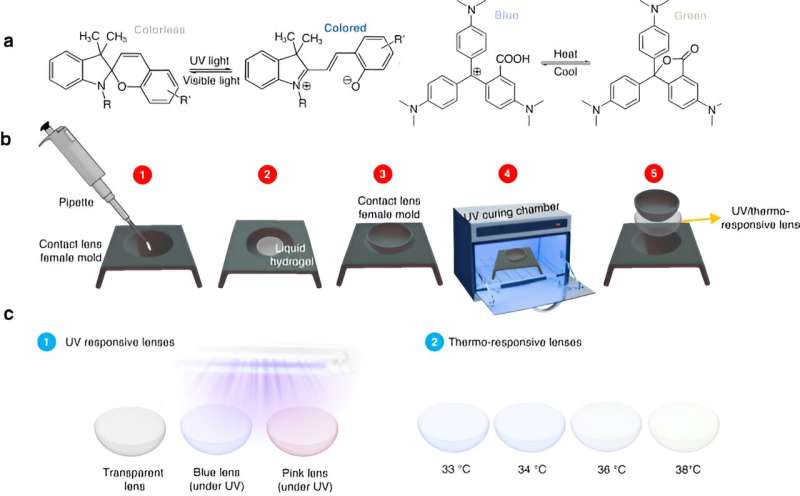This article has been reviewed according to Science X's editorial process and policies. Editors have highlighted the following attributes while ensuring the content's credibility:
fact-checked
peer-reviewed publication
trusted source
proofread
Team develops contact lenses that respond to UV and temperature changes

The global rise in ocular diseases, largely due to insufficient ophthalmic diagnostics and monitoring, has emphasized the need for better treatment methods. Pioneering developments in therapeutic and diagnostic contact lenses are now offering hope in treating these diseases.
Cataracts, which cloud the lens of the eye, are a prime example, affecting 94 million people and leading to 10 million surgeries annually. A significant factor in the rise of cataracts and other ocular conditions, such as age-related macular degeneration (AMD) and photokeratitis, is excessive exposure to ultraviolet (UV) light.
In response, a team of researchers at Khalifa University has developed state-of-the-art UV protective contact lenses. Prof. Haider Butt and Ph.D. student Ahmed Salih, both Department of Mechanical Engineering, developed their lenses using smart materials such as photochromic and thermochromic powders. They have unique optical attributes depending on their activated and inactivated states. Their findings were published in Light: Science & Applications.
Photochromic powders change their structure in response to UV, while thermochromic ones react to temperature variations. When integrated into lenses, they can offer a simpler, cost-effective solution for managing and possibly preventing a range of eye conditions.
Under regular lighting, these transition contact lenses effectively block about 45% of UV and 20% of blue light. When exposed to UV radiation, the lenses darken in real time, absorbing portions of visible light. The speed and intensity of this transition vary based on the specific photochromic material used.
The use of different thermochromic and photochromic powders allows for user-specific customization, allowing wearers to choose lenses based on their unique needs. For instance, blue transition lenses react swiftly, with 95% of their color change reverting in less than five seconds after exposure to UV light. Pink lenses, however, offer more intense coloration but they take more than 30 seconds to return to transparency.
Yet, UV isn't the only factor impacting eye health. Fluctuations in ocular surface temperature, normally between 31 to 37°C, have been connected to issues like dry eye, glaucoma, and diabetic retinopathy. This has spurred interest in real-time temperature monitoring using advanced contact lenses.
The Khalifa University team's lenses are temperature-sensitive and multifunctional, displaying optical changes within physiological conditions. They darken outdoors due to UV rays from sunlight and respond to changes in temperature.
The team's multifunctional lenses showcase impressive UV and blue light filtering capabilities alongside colorimetric temperature responses. They stand poised to serve as both therapeutic and diagnostic tools, and as ocular diseases become more prevalent, this innovative use of smart materials in contact lenses may play a pivotal role in safeguarding our vision.
More information: Ahmed E. Salih et al, Multifunctional transition and temperature-responsive contact lenses, Light: Science & Applications (2023). DOI: 10.1038/s41377-023-01304-1





















